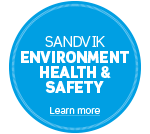Watch out for wolves
Canada. Fox footprints trail off into a grove. Wolves patrol the area, too. But it’s clear from the tracks in the snow that the McArthur River mine, deep in the wilderness of northern Saskatchewan, has found a way to coexist with the natural inhabitants.
“Warning: Wolf” says a poster on the wall of a building at the McArthur River mine, along with a photo taken from some distance. The grey creature had been spotted near one of the main buildings. That’s what happens when the world’s richest uranium mine is 600 kilometres away from the nearest city. People and animals have to share space, says Kevin Huber, senior coordinator for environment, health and safety at McArthur River.
“We want to protect that,” he says. “As long as they are not aggressive or start to attack people, we won’t have to do anything, except make sure that our employees pay attention to their surroundings.”
Huber has been at the McArthur River mine for eight years, and he worked at several other mines before that. Cameco’s environment, health and safety (EHS) standards are the highest he has experienced, by a wide margin.
“This is the Cadillac of EHS,” he says with a laugh.
Cameco’s basic principles are based on the five-point safety system introduced in 1942 by Neil George, a Canadian pioneer in mine accident prevention.
They are:
# Check the entrance to the workplace.
# Are the workplace and equipment in good order?
# Are people working properly?
# Do an act of safety.
# Can, and will, people continue to work properly?
On top of that, supervisors at McArthur River provide the workers with a card to carry all day, stating what they need to know about the tasks at hand.
“Of course,” explains Huber, “in the mine you are required to wear a hardhat, safety glasses, steel-toed boots, coveralls, hearing protection, gloves and a self-rescuer in case of a fire and smoke development.”
Workers who spend all their time underground are also required to carry devices that capture dust, which is then analyzed as part of a comprehensive radiation protection programme that keeps miners safe.
Inside McArthur River’s emergency response room is a large fire truck next to an ambulance. Cage-like lockers in the middle of the room hold the firemen’s gear, ready to be donned if ever needed.
The miners here include 60 trained emergency responders who can get a call at any moment.
“We can respond to pretty much anything,” Huber says. “We’re totally self-contained up here.”
Even though there hasn’t been a severe accident, employees may feel more at ease knowing that their first responders have won awards at national emergency response competitions.
McArthur River also houses a number of John T. Ryan safety trophies, which are awarded to Canadian mining companies with superior safety performance and the lowest number of reportable injuries.
“We’ve been fortunate to win both regionally and nationally, placing us among the safest mines in Canada,” Huber says. “Last spring we won the Mine Rescue Response in the underground portion of the competition, and in the fall we won the surface portion, too.”
Most of those involved attribute their success to the fact that EHS is a core value, and the EHS department is not holding back in its demands for equipment if it enhances safety.
The latest drill from Sandvik Mining, for example, came with a number of new, improved safety features. Among other things, it has a pipe clamp that can lift the pipe on and off the drill.
“That keeps our workers away from the rotating parts, which is huge,” says machine operator Dallas Taylor, one of the first responders and a member of the winning team. “That is one of our main dangers. It also helps with the lifting of the rods. The steel we’re using is fairly heavy.”
Huber says the few accidents and injuries McArthur River has are mostly strains and sprains.
“The challenge for us is to keep improving,” he says. “We want to continue to improve when it comes to the safety of our workers and the environment around us. When we leave this mine we want it to be like when we found it.”

/https%3A%2F%2Fsolidground.sandvik%2Fwp-content%2Fuploads%2F2014%2F05%2FMcArthur_River_01_EHS.jpg)
/https%3A%2F%2Fsolidground.sandvik%2Fwp-content%2Fuploads%2F2014%2F05%2FMcArthur_River_02_EHS.jpg)
/https%3A%2F%2Fsolidground.sandvik%2Fwp-content%2Fuploads%2F2014%2F05%2FMcArthur_River_03_EHS.jpg)

/https%3A%2F%2Fsolidground.sandvik%2Fwp-content%2Fuploads%2F2023%2F01%2FBackground-2-e1674718920429.jpg)
/https%3A%2F%2Fsolidground.sandvik%2Fwp-content%2Fuploads%2F2023%2F01%2FSmart-parts_2_1600x750.jpg)
/https%3A%2F%2Fsolidground.sandvik%2Fwp-content%2Fuploads%2F2021%2F10%2FDSC_2445_B_1600x570.jpg)
/https%3A%2F%2Fsolidground.sandvik%2Fwp-content%2Fuploads%2F2021%2F09%2FRM1_1600x570.jpg)
/https%3A%2F%2Fsolidground.sandvik%2Fwp-content%2Fuploads%2F2020%2F06%2FMining-Machine-Exploded_1600x570.jpg)
/https%3A%2F%2Fsolidground.sandvik%2Fwp-content%2Fuploads%2F2019%2F10%2F47246191292_1600x570.jpg)
/https%3A%2F%2Fsolidground.sandvik%2Fwp-content%2Fuploads%2F2019%2F10%2FHenrik_Ager_foto_oskar_omne0015_1600x570.jpg)
/https%3A%2F%2Fsolidground.sandvik%2Fwp-content%2Fuploads%2F2019%2F10%2FGearingUp_1600x570.jpg)
/https%3A%2F%2Fsolidground.sandvik%2Fwp-content%2Fuploads%2F2020%2F01%2FNAPO190528AL_020_1600x570.jpg)
/https%3A%2F%2Fsolidground.sandvik%2Fwp-content%2Fuploads%2F2019%2F08%2FBasic_1600x570-Greenwood-02.jpg)
/https%3A%2F%2Fsolidground.sandvik%2Fwp-content%2Fuploads%2F2019%2F04%2FIll-Sandvik-SustainMining_part2.jpg)
/https%3A%2F%2Fsolidground.sandvik%2Fwp-content%2Fuploads%2F2019%2F04%2FFlexible-financing_01_1600x570.jpg)